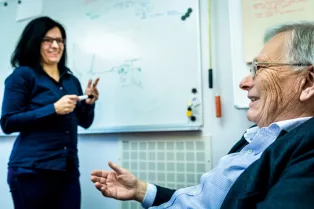We meet in Professor Sven Påhlman’s office at Medicon Village. After her latest employment at the Nordic Centre for Earth Evolution – a collaboration between the University of Southern Denmark and the Swedish Museum of Natural History – Emma Hammarlund has for the last couple of years collaborated with Sven Påhlman and his research team. The researchers recently published their first joint article in Nature Ecology & Evolution and are both surprised at how well their cooperation has progressed. Taking an evolutionary approach is not something a cancer researcher normally does, nor is it common for a geobiologist to adopt a cell perspective.
It was Emma Hammarlund’s frustration over the “oxygen paradigm” that started it all.
“It took nearly four billion years of the Earth’s history before animal life dramatically emerged through what is known as the Cambrian explosion. Why did it take so long? Geologists have for long linked it to the increase of oxygen in the atmosphere, but there is still no evidence to support this claim”, explains Emma Hammarlund.
On the contrary, research shows that major changes in air oxygen levels occurred both before and after the Cambrian period, but not in fact at the point when animals began to emerge. Other studies also show that simple animals require surprisingly low oxygen levels to survive.
“Our increased understanding of the Earth’s history and the origin of life does not support the old thesis. Meanwhile, alternative explanations have so far had a hard time generating the same impact, and we’ve practically banged our heads against the wall to find geochemical evidence of how the oxygen levels changed”, says Emma Hammarlund.
She speculates that the dramatic evolution of animals is due to a specific biological change and draws parallels to photosynthesis.
“We attribute biological inventions to other major revolutions for life on Earth, like when some microbes suddenly managed to perform photosynthesis. But as far as animal evolution is concerned, many people say that it involved an environmental change – without presenting any convincing evidence.”
Emma Hammarlund was convinced that the knowledge from tumour biology could help her move on to the question of how the animals evolved, which is why she contacted Sven Påhlman. His research on oxygen deficiency in cells seemed relevant to understanding the development of multicellularity.
“Because geologists like myself are not able to reconstruct the Cambrian explosion in the laboratory, I wanted to understand more about the multicellularity that tumour researchers see every day, and what they know about how oxygen affects the formation of tissue. Tumours, after all, are a successful kind of multicellularity.”
Sven Påhlman, on the other hand, was not equally certain about what the meeting could accomplish.
“I figured that since geology is so far from my own world, what on earth would we talk about? But I also felt obliged to give it a chance.”
The first meeting between Sven Påhlman and Emma Hammarlund proved to be very rewarding and was the start of an unusual type of collaboration on an unconventional research project about the emergence of animals on Earth.
“Generally, we see oxygen deficiency as a threat but forget that it, to some extent, is also a necessity for multicellular life. Our stem cells, which form new tissues, are extremely sensitive to high oxygen levels and, therefore, the cells have different systems in place to handle it. This is evident in tumours”, explains Sven Påhlman.
By studying the ability of tumour cells to mimic the properties of stem cells, Sven Påhlman discovered that tumour cells simply kidnap specific systems in the cell to circumvent the effects of high oxygen levels. As a result, the tumour cells may acquire stem cells properties, even though they are surrounded by the high oxygen concentrations that are also present in the body.
“This ability can probably also be found in our normal tissue, and we consider this to be an evolutionary success. So we’ve turned the perspective around: low oxygen is not a problem – our cells are used to managing oxygen deficiency. High oxygen levels, on the other hand, present a challenge for regenerating tissue”, says Sven Påhlman.
The new hypothesis entails that the dramatic arrival of animals originated in a revolution in the animal’s own biology and not in a change in the Earth’s atmosphere. The hypothesis may also have further significance for how we look at the ability of different animals to live in oxygenated environments and perhaps also for the way we consider cancer as an evolutionary consequence of our own ability to live in an oxygenated environment.
After overlapping their expertise, both Emma Hammarlund and Sven Påhlman were surprised that the human ability, over millions of years of evolution, to regenerate tissue despite high levels of oxygen, has not been considered before.
“Humans work perfectly well in high oxygen environments, with no signs of it being a struggle and achievement. But the ability that enables us to live in an oxygenated environment can also go wrong and eventually lead to certain tumours. Our perspective could therefore also provide us with a new way of looking at cancer.”
The road to publishing has not been entirely straight and has involved many challenges as the two researchers had to agree on a common approach and speak the same language. They are also quite convinced that there are many who will object to their model.
“We turned the binoculars around, and once we did that it was possible to see how our observations are related – then there’s no going back. Sven and I have had an unusual and very interesting collaboration throughout the process, and now we’re excited to see what kind of response we will get”, concludes Emma Hammarlund.
Text: Åsa Hansdotter
Photo: Kennet Ruona



